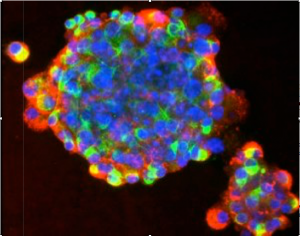Stem Cells

Pretend you are a scientist researching a new drug for liver disease. You have decided you would like to test your drug out on a very specific type of liver cell. So you take some cells you harvested from liver tissue and you grow them in colonies (which are very hard to keep alive), feed them complex nutrients to grow and thrive, and stabilize them in an environment conducive to their growth. Have you gone crazy yet? Well if you haven’t, imagine collecting the best growing cells, re-plating them and growing them again. Then picking the best cells and growing those cells again. And again. Then imagine watching the plates of those little cells you nursed to life die at the site of your new drug. Are you frustrated yet?
Stem cells could take all the guesswork and frustration out of growing cells. With the proper nutrients—or growth factors, stem cells have the potential to become the exact cell you select them to become. The growth factors send chemical signals to the cells that tell them exactly what type of cell they need to be. What a revolution!
So, where do these cells come from, anyway?
Stem cells can be found in a variety of places.
1. Stem cells that come from embryos can be very useful. Now, when I say embryo, I am referring to a four to five day old cell mass that will later form a fetus. The cells in the embryo can give rise to ANY adult cell type excluding the placenta. The embryos that are used currently include human and mouse cell embryos.
2. Fetal stem cells come from the immature and undeveloped organs of a fetus. For comparison, an embryo is considered to be a fetus after about the 9th week of gestation.
3. A developed organism contains adult stem cells. There are two types of adult stem cells: Germline and somatic. Germline stem cells can become gametes-or sex cells like the sperm and egg cells, while somatic cells can divide into another cell of the same type. So if you add growth factors to a skin somatic cell, that cell will divide to create more skin somatic cells. Many adult stem cells come from the bone marrow and can differentiate into various blood cells and immune cells.
4. The amniotic fluid that surrounds the developing fetus also contains stem cells. The amniotic stem cells are some of the most interesting cells because not only can they change into any cell, they are also highly active, can grow and change without growth factors, and rarely form tumors. It is possible to extract these cells from the mother while the child is in the womb without consequence to the child or the mother.
What is all the controversy about?
Some stem cells come from the human body and some from aborted embryos and fetuses. So you probably can imagine that there has been a great deal of controversy over the use of stems cells for research. People may feel that human life is being devalued due to where the cells are coming from. Others argue that scientists are “playing God” or teeter tottering on the line of human cloning. Supporters tend to believe that stem cells would be very useful for research and could put us on a fast track to curing diseases and saving lives. Either way, everyone is entitled to his or her own opinion.
Many nations including several of the states in the US have constructed laws to deal with some of these issues.
Check out the Laws in your state at the National Conference of State Legislatures.
Let’s talk bone marrow transplants
Inside your hollow long bones (like those of the hip) lies bone marrow containing many stem cells. The stem cells in the bone marrow eventually become your body’s blood cells and immune system cells. In patients with diseases such as leukemia (a cancer of the leukocytes—or white blood cells), the bone marrow becomes very “sick” and is unable to produce healthy stem cells. Therefore, they could fall very ill or die due to a poor immune system.
With a bone marrow transplant, however, people with bone marrow, immune system, and blood diseases can become healthy again!
How does this work?
There are two major ways.
First of all, a person’s stem cells can be “cleaned” and put back in. A few days before the process occurs, the donor is given some medication to help their bone marrow stem cells move from their bones and into their blood stream. Then the stem cells are collected from the blood, taken out of one arm, filtered though a machine and entered back into the other arm.
When “cleaning” isn’t enough, a very sick person will need a complete bone marrow transplant from a donor. The donor is a person with a nearly perfect tissue type match who can donate healthy bone marrow to the sick recipient. In this case, the donor will be put under with anesthesia and will have their bone marrow removed from one of their long bones—usually the hipbone. At the same time, the recipient will be put on chemotherapy or radiation to eliminate the “sick” marrow from his body so that the healthy bone marrow from the donor can be injected in its place. If the donor healthy marrow takes to it’s new body, then the recipient will grow new healthy marrow and hopefully be alleviated of the symptoms of their disease.
This process can be painful for the donor, but being a donor can be very rewarding. Finding the perfect match for a sick person can be like winning the lottery. The odds of a perfect match are often slim to none. This is why becoming a donor can play such a special role in someone’s life. For more information on becoming a donor check out “Be the Match” .
Be someone’s hero and sign up to “be the match”. Stem cells can help save someone’s life!


